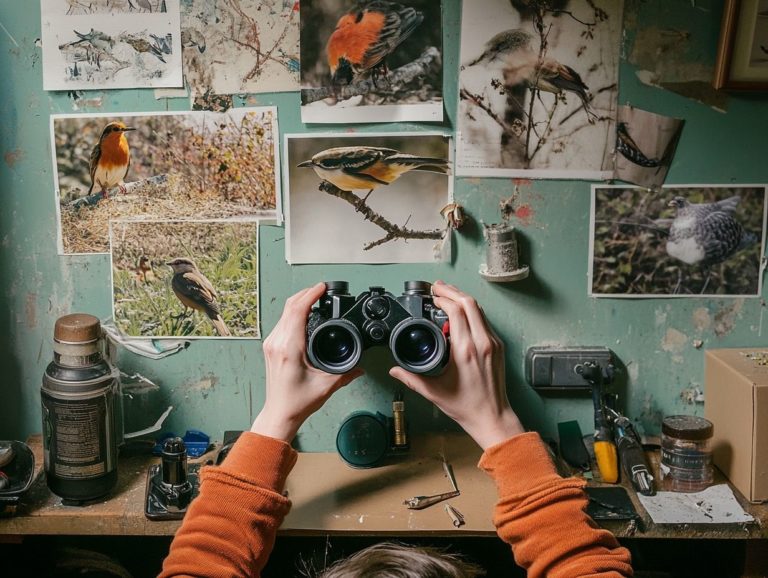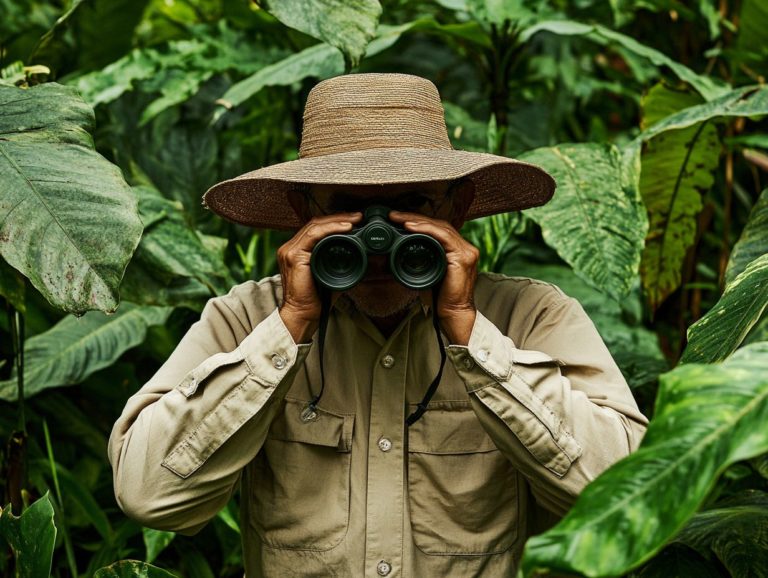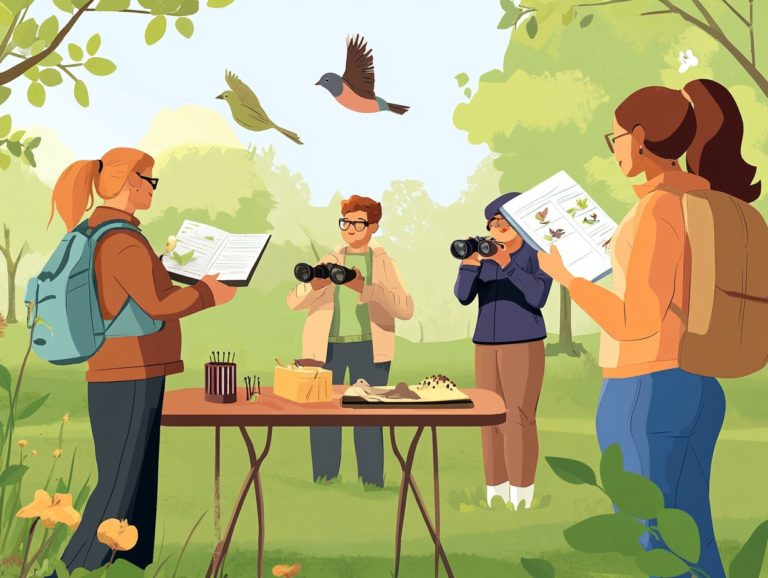How Can I Spot Birds More Effectively in Dense Forests?
Observing birds in dense forests is a challenging yet exhilarating endeavor. The thick canopy and vibrant foliage often make it difficult to spot these elusive creatures.
This article explores the unique challenges posed by such environments and examines how birds have adapted their behaviors for survival. It also provides practical tools and techniques for bird watchers, along with best practices to enhance the birdwatching experience.
The importance of conservation and ethical considerations regarding the protection of birds and their habitats will also be addressed.
Contents
- Key Takeaways:
- The Challenge of Spotting Birds in Dense Forests
- Understanding Bird Behavior in Dense Forests
- Tools and Techniques for Spotting Birds
- Best Practices for Bird Spotting in Dense Forests
- Conservation and Ethical Considerations
- Frequently Asked Questions
- How can I spot birds more effectively in dense forests during nature walks?
- What should I look for when spotting birds in local birding trips?
- How can I attract birds to a specific area using bird feeders?
- What time of day is best for spotting birds?
- Are there specific trees or plants that attract birds in forests?
- How can I improve my bird spotting skills using ornithology books?
Key Takeaways:
- Utilize binoculars and other equipment to enhance your bird spotting abilities in dense forests.
- Learn about bird behavior and how they adapt to their environment to better understand when and where to find them.
- Respect the birds and their habitat by following ethical considerations and best practices for bird spotting in dense forests.
The Challenge of Spotting Birds in Dense Forests
Bird watching in dense forests presents challenges that can deter even experienced bird watchers. The numerous layers of vegetation, thickets, variable lighting, and the sheer diversity of species in these environments make it difficult to spot and identify birds.
Furthermore, the presence of urban birds that have adapted to these settings complicates the task. Understanding the importance of conservation efforts in these habitats is also essential for promoting sustainable birdwatching practices.
This article explores the various factors that contribute to these challenges and offers tips on how to successfully find birds in forested wetlands.
Factors that Make it Difficult
Limited visibility and complex soundscapes, along with the behaviors of various bird species, contribute to the challenges of spotting birds in dense forests. Thick foliage can obstruct sightlines, making it difficult to see a perched bird or one flying through the branches.
Additionally, intricate soundscapes can make it challenging to distinguish specific bird calls from the background noise of other forest sounds. Each species exhibits unique behaviors and patterns that can either aid or complicate their identification.
Consequently, sharp observation skills are essential for bird watchers, enabling them to detect even the smallest movements or subtle differences in calls, enhancing their ability to identify birds in such a demanding habitat.
Understanding Bird Behavior in Dense Forests
Understanding bird behavior in dense forests is essential for bird watching, as different species have various adaptations that influence their visibility and activity patterns. The intricate structure of dense forests, along with factors such as habitat composition, food availability, and weather conditions, significantly impacts bird behavior, especially in wetlands and wooded areas.
Incorporating mindfulness practices can enhance the birdwatching experience by fostering qualities like patience and keen observation, enabling bird watchers to notice the subtle nuances of avian life more effectively.
How Birds Adapt to Their Environment
Bird species have developed specific adaptations that enable them to thrive in dense forests. These include specialized feeding habits, nesting behaviors, and camouflage techniques. Such adaptations vary significantly between species, particularly in wetlands, where high water levels and dense vegetation present unique challenges.
For instance, wading birds possess long legs and beaks that allow them to probe deeply into the mud for food, while other species have webbed feet for more efficient swimming. These adaptations enhance hunting and foraging abilities and aid in evading predation.
As conservation efforts increasingly focus on these critical habitats, understanding the unique needs of various bird species becomes essential. By recognizing how changes in habitats impact these adaptations, environmental organizations can develop more effective strategies to protect both the birds and their ecosystems.
Join us on this exciting journey and start your birdwatching adventure today to connect with nature!
Tools and Techniques for Spotting Birds
Utilizing the right tools and techniques is essential for enhancing the bird-watching experience. This is particularly important in forests where visibility can be challenging. Binoculars allow enthusiasts to clearly observe distant birds. A field guide helps with quick identification of various species.
Employing effective observation techniques and photography tips can further enrich the bird-watching experience as well.
Binoculars and Other Equipment
Binoculars are essential for birdwatching! They enable enthusiasts to observe birds from a distance without disrupting their natural behaviors.
A variety of binoculars is available to cater to different needs and preferences. This includes compact models that are lightweight and easy to carry on long hikes, as well as high-powered versions that offer remarkable clarity and detail.
Birdwatchers find that the choice of zoom level and lens size can significantly impact their overall experience. Other important tools include field guides providing information about various species, along with mobile apps for immediate access to bird calls and community insights.
These resources can enhance observation skills and increase the enjoyment of discovering the diverse avian world.
Sound Identification
One of the most thrilling aspects of birdwatching is learning to recognize bird calls! Sound identification is the ability to recognize birds by their calls and is a valuable skill.
This skill is particularly useful in dense forests, where many birds are present, but few open spaces allow for observation. The ability to discern differences in sounds is crucial since the calls of various species often sound similar.
Listening closely is important, as even minor differences can help distinguish one species from another. Many apps available assist with sound recognition.
The ability to distinguish sounds enhances the overall birdwatching experience. It sharpens the observational skills of birdwatchers and allows for a more immersive experience in nature, leading to richer and more rewarding experiences.
Best Practices for Bird Spotting in Dense Forests
Don’t miss out on the best time for birdwatching! Early morning is the ideal time as birds are more active during this period.
The surroundings are generally quieter, making it easier to spot them.
Tips for Maximizing Success
Want to enhance your birdwatching skills? Here are the best practices! These involve enhancing observational skills and discovering local areas rich in diverse species and habitats.
Engaging in community projects focused on bird conservation enriches the experience and fosters connections with others who share the hobby.
Utilizing the eBird application provides valuable information on local bird distributions and seasonal patterns. This helps enthusiasts find the optimal times and locations for bird observation.
Practicing patience and attentiveness will further develop observational skills, enhancing enjoyment of nature.
Participating in conservation efforts helps manage natural habitats and ensures future generations can enjoy these sights!
Conservation and Ethical Considerations
Conservation and ethics are essential components of responsible bird watching. They foster the protection of bird habitats and ensure the welfare of various bird species.
Respecting the Birds and Their Habitat
Ethical bird watching is vital for protecting bird species. It fosters respect for birds and their habitats.
As ethical bird watchers appreciate birds and their environments, they are more likely to join conservation efforts. This commitment includes following local guidelines that protect nesting areas.
Join community projects to restore natural habitats. These efforts encourage environmental stewardship.
Connecting with fellow bird watchers helps share experiences that support sustainable environments. Together, we can improve life for birds and boost biodiversity for future generations.
Frequently Asked Questions
How can I spot birds more effectively in dense forests during nature walks?
Use binoculars! They help you see birds like hawks or woodpeckers high in the trees.
What should I look for when spotting birds in local birding trips?
Look for movement! Birds flutter their wings or rustle leaves, making them easier to spot.
How can I attract birds to a specific area using bird feeders?
Use bird calls or set up feeders, especially in the early morning. Curious birds will come to investigate!
What time of day is best for spotting birds?
Early morning or late afternoon is ideal. The lighting during these times makes spotting birds easier.
Are there specific trees or plants that attract birds in forests?
Fruit-bearing trees and plants attract many birds, including egrets and hawks. Look out for these while bird watching!
How can I improve my bird spotting skills using ornithology books?
Practice makes perfect! Use ornithology books to learn about different bird species and be patient while scanning the trees.





